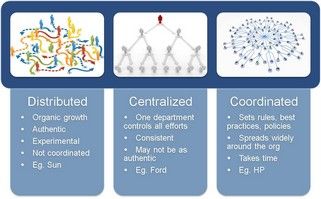Social Media In Corporations: Pros & Cons Of Organizational Models
I dove into my “Big Thinking” folder recently and emerged with a slide from the “Social Media Trends for 2010” deck created by Jeremiah Owyang of the Altimeter Group, discussing organizational models for corporate adoption of Social Media.

Who is in control of this Social Media stuff? What are the best practices?
These questions come up a lot, particularly amongst large brands.
Imagine: you have THOUSANDS of employees, who are not asking for your so-called permission to hang out on Facebook or Twitter; who may be blogging (with or without full transparency); who are likely finding and commenting (with or without full transparency) on industry blogs that cover your business. The situation could escalate out of control pretty quickly, especially in times of crisis.
Jeremiah’s slide points to the three major options that large corporations must consider re: Social Media adoption and planning.
The distributed model is the most compelling because it’s the least controlled; it’s a mess, a free-for-all. Everyone in the company gets to chart their own path. Join Twitter – or not. Join Facebook – or not. Start a blog – or not. It’s the model that most companies fear the most – it is hard to monitor or contain. Yet its very looseness gives it power. Untethered, the company’s overachievers can rise to the top; they can become authoritative “personal brands” in the industry, and could help the business in surprising ways. Two types of companies adopt this distributed approach: companies that fail to plan (and wind up hoping for the best) and, companies willing to put inordinate amounts of trust in their employees (see: Zappos).

The centralized model is the “default setting” for most large companies. Accustomed to CONTROL, this approach feels proper and minimizes surprises. There’s one neck to choke when things go awry. However, the rigidity of this model ignores the power of Social Media – to expose the company’s talented folks, at all levels, to various niches in which they might be impactful. The centralized approach is superb for Brand Management and Customer Service but doesn’t answer the question about what everyone else in the company wants to do re: Social Media! “Are you saying that because I’m not part of your Social Media team, I can’t tweet?” It begs for end-runs from within the company.
Clearly the coordinated model in Jeremiah’s slide is the one to espouse. It’s beauty is that it is simple, reasonable and effective. Guidelines are set (simple). Monitoring and reporting mechanisms are deployed (reasonable). Everyone gets to play, but knows the rules-of-the-road (which will evolve as new lessons are learned), and also knows that there are consequences for derailing the company’s brand online (effective).
But, as Jeremiah’s slide rightly notes, the effectiveness of this approach can take more time.
The coordinated policies might allow for great public-facing successes in Customer Service, for example, but might not do as good a job showcasing the talents of employees in other divisions. The Social Media zealot working in a company with a “distributed” (free-for-all) approach will be self-motivated to make a mark; they’ll be fueled by ego to get noticed — and to make an impact before anyone in “Corporate” figures out that they need to set guidelines. That same employee, working within the regulations set in a “coordinated” model, might find that spadework to be slower going.
What approach appeals the most to you? What model does your current employer use (wittingly or not)? Do you see that situation changing?
Continue reading here: The Scandal That Will Knock Marketing On Its A$$
Was this article helpful?


